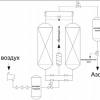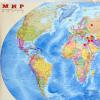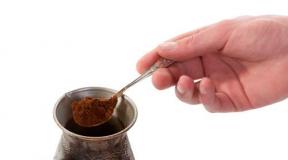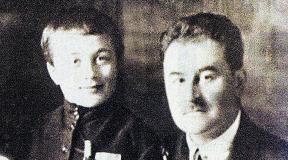What medications are effective for treating and preventing colds and flu? Which drug is better, “Cycloferon” or “Remantadine” and how they differ
Scientists from St. Petersburg studied the effectiveness of various anti-influenza drugs in laboratory animals infected with different strains of the influenza virus. It turned out that immunostimulants from the group of inducers of interferon synthesis are effective against strains resistant to other drugs, as reported on the website of the Scientific and Technical Foundation "Polisan".
Researchers from the St. Petersburg Research Institute of Influenza of the Russian Academy of Medical Sciences and the Department of Infectious Diseases of the St. Petersburg State Medical Academy named after Mechnikov studied the antiviral activity of the drugs methylglucamine acridone acetate (), () and rimantadine () against the following strains of the H1N1 influenza virus: A/Swine/1976/31, isolated from pigs, human A/Puerto Rico/8/34, resistant to rimantadine, and human A/Vladivostok/2/09, resistant to oseltamivir.
Methylglucamine acridone acetate is an immunostimulant - an inducer of the synthesis of interferons (substances with antiviral activity produced in the human body), oseltamivir is a blocker of the viral enzyme neuraminidase, and rimantadine blocks a protein called M2, preventing the virus from entering the epithelial cells of the respiratory tract.
Without treatment, most animals died a few days after infection from influenza pneumonia (pneumonia).
In the group infected with A/Swine/1976/31, the mortality rate of animals without treatment was 75 percent. When using Cycloferon it decreased to 40, Tamiflu to 30, and Remantadine to 20 percent.
After infection with A/Puerto Rico/8/34, which is resistant to rimantadine, 80 percent of untreated animals died. Tamiflu was the most effective in this group, reducing mortality to 23.5 percent. Cycloferon reduced this figure to 35.3 percent. When treated with Remantadine, 46.2 percent of animals died.
Virus A/Vladivostok/2/09, resistant to oseltamivir, caused the death of 60 percent of animals without treatment. Prescribing Remantadine reduced mortality to 3.8, Cycloferon to 29.2, and Tamiflu to only 36.8 percent.
Thus, the most effective drug when infected with strains of the virus that are sensitive to it, Remantadine is used. The antiviral activity of Tamiflu also turned out to be high. The advantage of Cycloferon is that it is effective against any type of virus, including those resistant to other antiviral drugs. At the same time, resistance of the influenza pathogen to Cycloferon is not developed, since this drug does not act on the virus itself, but on antiviral immunity.
Source of information: Medportal.ru
"Cycloferon" has established itself as a reliable and effective medicine that can influence the synthesis of immune cells - interferons. Thanks to this property, it has a preventive and therapeutic effect against diseases caused by viruses. Are there any analogues of Cycloferon in tablets? Is it acceptable to use them for children? Which drug is preferable for complicated ARVI? You will find answers to all these questions in the article.
The principle of action of "Cycloferon"
"Cycloferon" has an antiviral and immunomodulatory effect. It is used in the prevention and treatment of pathological conditions of a viral nature. This drug stimulates the production of interferons, which are essentially human immune cells.
Available in the form of tablets and solution. There is also an ointment (it has proven itself excellent in the treatment of herpes, vaginitis, urethritis, periodontitis, balanoposthitis and others). "Cycloferon" is not available in suppositories or other forms.
By stimulating the production of interferon by the body's cells, Cycloferon is able to actively fight against many viral infections: parainfluenza, viral hepatitis, tick-borne encephalitis, papillomavirus, HIV.
For hepatitis, Cycloferon will ensure the transition of the disease from a complex acute form into chronic. For HIV, in complex therapy it will help strengthen the immune system. Simultaneously with the increase in interferon production when taking Cycloferon, the activity of macrophage cells is stimulated. The maturation of stem cells accelerates, and as a result, leukocytes, including neutrophil granulocytes, are suppressed. Stimulation of cellular and humoral immunity makes Cycloferon useful not only for viral infections, but also for some bacterial infections.
Possibility of use in children
The drug is used for children and adolescents in injection and tablet form for the following diseases:
- ARVI and influenza;
- viral hepatitis B and C;
- urethritis, periodontitis;
- meningitis, borreliosis (as part of complex therapy);
- balanoposthitis;
- some intestinal infections.
Contraindications and symptoms of overdose
The exact dosage and duration of treatment is determined by the doctor. When using injections or ointments, toxic effects on internal organs is shrinking. If you have chronic liver and gallbladder diseases, you should abandon oral administration in favor of injection administration. The drug is administered intravenously or intramuscularly at 250-500 mg every day. The duration of treatment depends on the complexity of the disease.

The instructions for Cycloferon and analogues warn of the following contraindications for use in any form:
- Individual intolerance to the drug.
- Cirrhotic liver disease.
- Children up to four years of age.
In case of overdose, urticaria, fever, and toxic shock are possible.
Are there any equivalent substitutes for Cycloferon on the market?
It is worth immediately making it clear that below we will talk about analogues of “Cycloferon” and its substitutes in terms of their effects on the body.
The active ingredient of the drug "Cycloferon" is meglumine acridone acetate. There are simply no analogues of this drug that are equivalent in structural formula. But since "Cycloferon" belongs to the group of antiviral and immunostimulating medicines, then the choice of substitutes based on the principle of action on the body is quite extensive.
The cheapest is "Remantadine" which costs about one hundred rubles. Tamiflu is one of the most expensive substitutes (its cost is about one and a half thousand rubles). "Cycloferon" itself, depending on the form of release, will cost from three hundred to seven hundred rubles.
Analogues of "Cycloferon" are cheaper: list
The modern pharmacological industry makes it possible to develop a generic version of any drug. Does Cycloferon have cheaper analogues? Of course they exist. But it is worth considering that the cost directly depends on the production conditions. Saving on medicine may lead to purchasing a product with a less purified active ingredient. As a result, the overall effectiveness of therapy with this drug will be lower. Please take this into account when purchasing. Instructions and reviews of Cycloferon analogues can be read below.

List of drugs:
- "Amiksin" - will cost about two hundred rubles per package;
- "Rimantadine" of domestic or Ukrainian production will cost from one hundred to two hundred rubles;
- Echinacea tincture 100 ml will cost eighty rubles.
These drugs are also capable of providing an antiviral effect, albeit due to a different active substance. Reviews about Cycloferon analogues are varied - most consumers were satisfied, since the medicines helped them improve their health.
Echinacea tincture: properties, benefits and harms
Cheap and effective medicine. Strengthens the body's protective immune forces. Approved for use by children and adolescents. The low cost of the tincture allows you to use it for as long as you like. No overdose or allergic reactions were detected.
People with liver disease should treat Echinacea tincture with caution. The basis of the tincture is alcohol, and with daily use of even tiny doses (10-20 ml per day), ethanol will negatively affect the cells of this organ. If the liver is unhealthy, then constant use of alcohol tincture can trigger fatty degeneration of healthy cells.

Children's "Anaferon": placebo or medicine?
This drug at one time caused heated debate among pharmacists and doctors. Many still consider it a placebo. However, laboratory studies have proven that this is not the case. "Anaferon" has proven its antiviral effectiveness and is quite capable of being considered a full-fledged analogue of "Cycloferon" in terms of its properties. The instructions for use of the drug recommend that children under 18 years of age use a special children's "Anaferon" to avoid overdose.
"Anaferon" is created on the basis of ultra-low doses of antibodies to interferon gamma. Because of this, there is a false belief among people that the drug is homeopathic and is not able to speed up the patient’s recovery from diseases of a viral nature. However, laboratory studies have proven the presence of specific pharmacological activity against many groups of viruses, which allowed Anaferon to be included in the list of immunopharmacological drugs. For medical reasons, this analogue of Cycloferon has proven itself to be an effective remedy for ARVI, influenza and their accompanying symptoms. Parents especially loved using it as a preventative against childhood colds.
"Glatimer" as an analogue of "Cycloferon"
As mentioned above, there are no substitutes for the structural formula of Cycloferon. But the modern immunomodulating drug Glatimer is similar in action, although it has a much shorter list of indications for use.
Glatimer acetate belongs to the class of immunomodulators. But its scope of application is somewhat different than that of Cycloferon: it is more often prescribed to older people, and it has proven itself excellent in the treatment of multiple sclerosis. The very complex pharmacological action of Glatimer determines its relatively low effectiveness in the prevention and treatment of pathological conditions of a viral nature.
"Kagocel" or "Cycloferon"?
These drugs are very similar in their therapeutic effect. Both of them stimulate the induction of interferon and exhibit an indirect antiviral effect. Both “Cycloferon” and the analogue (instructions for use and reviews of users confirm this) “Kagocel” effectively restore humoral and cellular immunity.

"Kagocel" is produced in several dosage forms. Can be used to treat children from three years of age. Contraindicated in case of liver failure, gastric ulcer, frequent allergic reactions. Reviews of "Kagocel" confirm its preventive and medicinal properties for complicated acute respiratory viral infections, influenza, herpes rashes. A very popular remedy for treating children and adolescents.
"Immunal": indications for use and reviews
"Immunal" is prescribed for the prevention and treatment of existing viral infections. In terms of its effect on the body, it is an analogue of Cycloferon.
Main indications for use:
- stimulation of the immune system for frequent colds;
- chronic fatigue, constant stress;
- prevention of acute respiratory viral infections and influenza in adults during the cold season;
- as part of complex therapy of bronchitis;
- in complex therapy of viral hepatitis;
- for some types of dermatitis and herpes.
During pregnancy, taking "Immunal" is not recommended due to its ability to cause contractions of muscle tissue, which can lead to unwanted stimulation. In terms of cost, it is also an analogue of Cycloferon. Depending on the pharmacy chain and the number of tablets or ampoules, the price varies from two hundred to five hundred rubles.

"Inflamafertin" - a new generation antiviral agent
"Inflamafertin" contains a complex of placental peptides. Has an immunotropic effect. Its range of applications is much wider than that of Cycloferon. The instructions for the Inflamafertin analogue confirm its effectiveness in the following conditions:
- inflammatory diseases of the genital organs;
- treatment of adhesions after surgery;
- some forms of infertility;
- autoimmune pathologies connective tissue;
- HIV and AIDS;
- scleroderma;
- viral dermatitis;
- perioophoritis and salpingitis;
- rheumatoid arthritis.
This is a new generation immunomodulating drug. Its cost ranges from seven to fifteen thousand rubles. The drug is injectable and should be stored at a temperature no higher than five degrees. Perhaps in ten years this modern and effective immunomodulating drug will replace the modern "Cycloferon" in terms of availability.
"Amiksin" is a safe remedy for colds
Antiviral agent proven for decades. It was popular back in the Soviet years. Effectively relieves all manifestations of a cold already on the second day (runny nose, sore throat, lacrimation). One of the disadvantages of "Amiksin" is its almost complete failure in the fight against diseases of the genital organs of a viral nature. It is also practically useless for herpes, dermatitis and furunculosis caused by a virus.

This selective use makes it only partly an analogue of Cycloferon. However low price Amiksin covers this drawback: its cost varies from one hundred to two hundred rubles. Therefore, hundreds of thousands of residents of our country choose this product.
What infectious diseases worry us most often? The answer is simple - it's influenza and ARVI. They make up 70% of all reported cases infectious diseases. 9 out of ten people get sick with ARVI or influenza at least once a year. This is why the incidence of infectious diseases is so high.
Why does the respiratory tract suffer so often? There are simply too many negative factors affecting our respiratory system. This includes polluted air, chemical fumes, hypothermia, and viruses. We will talk about viruses and the fight against them. We are surrounded by many pathogenic microorganisms. The influenza virus mutates almost every year, making it more difficult for our immune system to work. It is joined by adenoviruses, parainfluenza, reoviruses, rhinoviruses, respiratory viruses, chlamydia, mycoplasma, and bacteria. All these viruses mutate quickly, easily penetrating the body. Most of these pathogens are primarily transmitted through airborne droplets. And this is a fairly easy way of penetration into the body.
The main barrier to viruses is the immune system. It is this that is designed to protect us from most viruses. But if the immune system is weakened, the disease gains strength and attacks our organs and tissues. When the immune system can no longer cope with the virus, antiviral drugs come to the rescue. Their peculiarity is that for maximum effect, you need to take them at the first signs of the disease. This way you will protect yourself from the toxic effects of viruses. Antiviral drugs can and should be used for colds. Let us remind you that acute respiratory viral infections, influenza and other viral diseases can provoke serious complications in the lungs and bronchi, as well as aggravate existing chronic diseases. Inexpensive antiviral drugs can help prevent this. Antiviral drugs for adults and children should be used at the onset of the disease. But what antiviral drugs are best to use for a particular patient will be determined by the doctor.
In the case of a cold, treatment will be more symptomatic. It is designed to lower temperature, reduce inflammation and avoid the toxic effects of viruses. Antiviral drugs may also be used. Possible side effects, but colds and flu can lead to much more serious complications. The cost of these drugs is quite affordable. Very often, antiviral drugs are used to strengthen the immune system and prevent them; the list is long.
If you have a cold, you should not take risks and self-medicate. For example, in the case of a cold, antibiotics will be useless, since they can only fight bacteria. And most colds are caused by various viruses. The best antiviral drugs have a broad spectrum. The doctor will prescribe broad-spectrum antiviral drugs, since determining which specific virus attacked the body is quite problematic.
What is the point of antiviral therapy?
A cold is not dangerous if the body has a strong immune system. But unfavorable ecology, stress, poor nutrition, bad habits, chronic diseases weaken the immune system day after day. When an infection attacks the body, there can be two ways the situation can develop:
- Strong immunity suppresses viruses, and the disease either does not begin or passes in a weak form.
- If the immune system is weakened and there is no antiviral therapy, the disease develops in full force, intoxication of the body occurs, which leads to complications.
So, if you have a strong enough immune system, the doctor will limit itself to treating the symptoms. It is designed to reduce fever, detoxification and inflammation. If there is a suspicion that the immune system is weakened, it will be necessary to take effective antiviral drugs. Do not confuse them with antibacterial ones. After all, the latter can eliminate bacteria, but are powerless against viruses. Antiviral drugs are effective against flu and colds. Colds and flu can be caused by the following viruses:
- influenza virus A, B, C;
- reoviruses;
- paremyxoviruses;
- coronaviruses;
- adenoviruses;
- picornaviruses.
Antiviral drugs should not be ignored. They can make the disease not so long and severe, and protect against the development of complications. It is also advisable to take them if there is already a sick person in the house.
Antiviral agents
Many antiviral drugs are inexpensive but effective. These are medications that should be used to treat and prevent influenza and ARVI. Antiviral medications for colds are very effective. If you find out which antiviral drug is the most effective, there will be no exact answer. It all depends on the dose and the patient’s sensitivity to it.
ARVI and influenza are quite difficult to distinguish. These diseases have very similar symptoms. Only a doctor can correctly differentiate them.
The main differences between ARVI and influenza:
- First signs of illness
- Symptoms of the disease
- Character of fever and catarrhal symptoms
- Type possible complications etc.
Therefore, it is important to make a diagnosis not just based on examination and patient complaints, but also on the basis of laboratory tests. The doctor prescribes the necessary tests and only based on their results prescribes treatment.
An antiviral remedy for colds will help avoid complications. ARVI can manifest itself in different ways, depending on what virus you are exposed to. Unfortunately, we often underestimate ARVI and believe that such infections are not dangerous. In 20-30% they can lead to serious complications from the respiratory and cardiovascular systems. You need to be especially careful during periods of epidemic. Weak immune defense leads to complications. The immune system is unable to resist viruses and they begin to destroy the body without any obstacles. It is especially dangerous if the immune system has been weakened for a long time. Because of this, the body loses the ability to repel the attacks of infections; they operate with might and main, provoking all sorts of complications. One of these unpleasant and dangerous complications is post-viral asthenia syndrome (PAS). Out of ten cases, six patients may suffer from this syndrome. It appears in the first month after the disease.
SPA symptoms:
- Emotional disturbances, depression;
- Chronic fatigue;
- Mental disorders.
How can you treat influenza and ARVI?
A wide range of drugs are used to combat influenza or ARVI. These include all kinds of vaccines (inactivated and live), chemotherapy drugs, drugs for pathogenetic treatment and drugs for correcting immunity. But it is quite difficult to control how the flu will progress. This disease is very unpredictable and dangerous due to its complications. There are a lot of influenza viruses. How it will proceed depends on the specific strain and the general condition of the patient. What is important is the state of his immune system, whether there are chronic diseases, as well as the age and condition of the body. The flu causes the most severe complications in the elderly and children. The influenza virus is variable and can cause large-scale epidemics. But ARVI spreads through slightly different mechanisms. They are related to the socio-economic situation in the country, the state of the environment, allergic diseases, etc.
Now let's look in more detail at what groups of drugs can be used for acute respiratory viral infections and influenza.
Antiviral agents
Chemotherapy
Modern antiviral drugs of the antiviral group work as follows. Their goal is to suppress individual links that are responsible for the reproduction of viruses. They act selectively. The main thing is not to disrupt the vital activity of the cell itself. You just need to suppress the virus that has penetrated inside it. If a patient is diagnosed with a respiratory disease, then two types of drugs are used - M2 channel blockers, as well as neuroamindase inhibitors. Ribavirin may be used. This is a cheap antiviral drug that can cope with some types of viruses.
What drugs are M2 channel blockers?
The year 1961 was very important for the improvement of antiviral treatment. Amantadine was synthesized. This substance is capable of blocking special ion channels in the virus. Because of this, the virus lost its ability to penetrate cell walls. Also, the virus could not release the ribonucleoprotein. In the USSR, rimantadine began to be widely used. It is effective for the prevention and successful treatment of influenza, which is caused by virus A. The effectiveness of rimantadine was astounding - 70-90%. And the whole secret of success was that this substance slowed down viruses at an important stage of their penetration into the cell. But since the influenza virus changes very quickly, scientists soon noticed that in 30% of cases the virus is resistant to the drug.
The drug Rimantadine is available in tablets (50 mg) and syrup. The syrup is more suitable for children 1-7 years old. It is important to start taking the drug before the onset of the disease to avoid infection. For prevention, it is enough to drink it for about two weeks. If the disease has already attacked, then it is important to take the medicine in the early stages of the disease, as soon as the first symptoms make themselves known. In order not to provoke virus resistance to this drug, in case of illness you can drink it for no more than 5 days.
Neuroamindase inhibitors
If rimantadine is effective only against viruses A, then neuroaminidase inhibitors are able to counteract influenza viruses type A and B.
What lies behind this scary and incomprehensible word “neuroamindase”? This is one of the important enzymes. With its help, the virus penetrates the cell. As is known from the school curriculum, viruses penetrate inside cell membranes and multiply there, weakening the host’s body and destroying its cells. When the synthesis of neuroamindase slows down, the virus is not able to disrupt the integrity of the cell and penetrate inside. Also, such a virus becomes less resistant to the action of our immunity. The human body has several barriers against viruses. One of them is a special secretion produced by the respiratory tract. Thanks to the action of neuroaminidase inhibitors, viruses become more susceptible to this secretion. Thanks to these inhibitors, the inflammatory local reaction stops its development. This means that the viral infection has a much weaker effect on the body. It will no longer provoke severe fever, loss of appetite, or muscle pain.
The effectiveness of such inhibitors, as studies have shown, ranges from 70 to 80%. Even if the virus has entered the body, the disease will last 1-2 days less in a milder form. But you need to take the inhibitor one or two days after the onset of symptoms. Once the disease has begun, after taking inhibitors, viral replication in cells will be reduced by about 3 days. At the same time, elevated temperature and more severe forms of influenza and ARVI were observed in only 15% of patients. It is very important that these drugs do not affect nervous system. The only drawback of such inhibitors is that it is advisable to take them in the first two days after infection with the virus. But doctors, in order to determine accurate diagnosis, sometimes it takes longer.
Neuroamidase inhibitors include the following drugs: zanamivir, oseltamivir. Azintomivir is an antiviral drug that is the active ingredient in the well-known Tamiflu. It is taken for 5 days at 75-125 mg twice a day. If the drug is taken for prophylaxis, it is prescribed 1-2 times a day, 75 mg. The course of preventive treatment is 4-6 weeks. If the patient's creatinine clearance is less than 30 ml/min, then the dose should be halved. This is why it is so important that the treatment is supervised by a doctor. After all, patients often cannot remember even the name. Azintomivir, azektomivir, ozitamivir - the antiviral drug is the same. Its correct name is azintomivir.
Zanamivir is better known as Relenza. It is an analogue of sialic acid. It is taken using a special inhalation device. For treatment, the drug is prescribed twice a day, 10 mg. (interval – 12 hours). Treatment lasts 5 days. Why is inhalation used to administer the drug? This method has a number of important advantages. This method provides quick results.
This group of drugs has a fairly good reputation. They practically do not lead to adverse reactions. Their share is extremely small and amounts to only 1.5%. This may be diarrhea, nausea, dizziness, sinusitis, headache. Very rarely, bronchospasm was observed in patients with pulmonary diseases.
Medicines that help fight other viruses
In addition to influenza and ARVI, viruses can cause a number of other diseases. For example, Ribavirin (Rebetol, Virazol) is used against such viruses. It is capable of influencing a number of viruses. Ribavirin can be used in aerosol form. It is used to fight infections caused by the RS virus. It is believed that this drug may slow down the early entry of the virus into cells. It disrupts the synthesis of messenger RNA and ribonucleoproteins and blocks RNA polymerase. A nebulizer is used for its inhalation administration. But this drug is administered only in a hospital and only as prescribed by a doctor.
Ribavirin should be taken with caution. It can provoke a rash and bronchospasm. The drug may also irritate the eyes, even of healthcare workers. Quite rarely, after taking it, patients experienced insomnia, leukopenia, and increased irritability. There is a possibility that the drug will crystallize in the respiratory tract. Ribavirin has a teratogenic effect.
The United States has recently developed a new antiviral drug that is considered very promising. It was called Plenoconaril. Animal experiments and in vitro studies have shown that it is indeed active against rhinoviruses and enteroviruses. When studies were conducted using placebo and Plenoconaril, the results were pleasantly surprising. The drug has shown effectiveness against enteroviral meningitis and various respiratory infections.
In Russia there is a lot of domestic research that formed the basis for the production of original antiviral agents. The most famous is Arbidol. This drug slows down viruses types A and B, as well as a number of other respiratory viruses. But the mechanism of its action is not fully understood. The drug is believed to have the property of inducing interferon and modulating immunity. Arbidol is capable, for example, of making phagocytic cells more active. The tablet contains 0.1 mg of the drug. For treatment, take 0.2 mg 3-4 times a day. The course of treatment is 3-5 days. For prevention, the daily dose will be 0.2 mg. The course of treatment is 10-14 days.
Preparations containing interferon
Interferons (IFNs) are also used for prevention and antiviral treatment. They are able to regulate the state of immunity. Interferons are produced in our body by different cells. They are responsible for protecting our body from all kinds of viruses, as well as for regulating the reactions of the immune system.
Effects of drugs that contain interferon:
- antiproliferative;
- antimicrobial;
- radioprotective;
- immunomodulatory.
Viruses are very diverse, but despite this, IFNs can effectively inhibit their reproduction process. This occurs at the stage through which any virus passes when it enters the host's body. This is the stage of so-called translation, when the virus synthesizes its specific proteins. That is why interferon is able to suppress the activity of various viruses. This is a universal remedy that nature gave to our body. When interferon starts working, the body increases the activity of its natural killer cells.
To successfully treat viral infections, two types of interferons are used: α- and β. But interferon alone cannot defeat viruses. It is advisable to combine drugs that contain interferon with chemotherapy.
Betaferon or β-interferon is produced in bottles that contain powder (9.5 million units of INF). To treat influenza, the drug can be sprayed into the nose or instilled. You need to use the drug at least 4-5 times a day. Leukocyte human interferon is used to treat ARVI and influenza, as well as a number of other viral diseases. It is synthesized by donors' blood leukocytes as a response to the virus. The result is a mixture of several interferons at once. It is better to administer the drug by inhalation or instill an aqueous solution into the nose.
Quite often, doctors prescribe Viferon. This is recombinant interferon α 2b. When an infection enters the body, it damages cell membranes. This significantly reduces the ability of interferon to counteract the virus. To stabilize cell membranes, Viferon included ascorbic acid, tocopherol acetate. These substances have a positive effect on the integrity of cell membranes; they are antioxidants. They enhance interferon activity by 10-14 times. Viferon is also available in the form of candles. It is believed that they better ensure the penetration of the drug into the blood, where it circulates for a longer time. Viferon is allowed to be used even for the treatment of newborns. Viferon-1 is available for children under one year of age. For older children and adults – Viferon-2.
Drugs that induce interferon
Interferon preparations can be combined with its inducers. There are quite a lot of such drugs. They can be synthetic or natural, high or low molecular weight. All of them are similar in that they can stimulate the production of the body’s own interferon. This interferon is called endogenous. In this case, various cells and tissues work: epithelium, macrophages, leukocytes, liver tissue, spleen, lungs and even brain. Such drugs can easily penetrate nuclear structures and cytoplasm. Their task is to activate the production of “early” interferon. Interferon inducers can enhance immunity. Let's look at a few drugs.
Amiksin known from advertising. This is an inductor of a synthetic nature. It is low molecular weight and belongs to the class of fluorenones. Amiksin is capable of inducing the production of endogenous interferon in patients. As soon as Amiksin enters the body, intestinal cells react to its administration. Interferon begins to be produced in leukocytes. Within 4-24 hours after the drug enters the body, maximum interferon production is observed. It is first produced by the intestines, then by the liver, and finally by the blood. It is best to take Amiksin in the first hours of the onset of the disease. For full course 5-6 tablets will be enough. For prevention, Amiksin is taken once a week. The course will be 4-6 weeks.
Cycloferon– low molecular weight inducer of IFN-α. Thanks to this, it has a wide spectrum of biological activity. It appears in cells quite quickly and accumulates in the cytoplasm and nucleus. Cycloferon also quickly penetrates into the blood. It binds weakly to blood proteins. But it is widely distributed in organs, tissues and biological fluids. Cycloferon is a low molecular weight drug. Therefore, it manages to quickly overcome the blood-brain barrier and stimulate the process of IFN formation in the brain. Cycloferon leaves the body fairly quickly. Within 24 hours, the kidneys excrete 99% of the drug unchanged. Patients tolerate this drug quite well. It is prescribed on the first day of the onset of the disease.
Ridostin– another IFN inducer. It is high molecular weight and of natural origin. It is a double helix RNA obtained from killer yeast lysate. If you use Ridostin systematically, you can effectively stimulate the production of early IFN. It was noted that after administration of this drug, IFN accumulates maximum in the blood plasma after 6-8 hours. It is no longer detectable in the bloodstream a day after the injection.
Ridostin has been observed to have a pronounced immune modulating effect. It stimulates the production of stem cells in the bone marrow and increases the level of hormones (corticosteroids).
Another drug in this group is Dibazol. It has been widely and successfully used, but lately new products began to supplant it. They started to forget about Dibazol, and in vain. This effective remedy prevention and treatment of influenza, ARVI. It is quite active in terms of modulating immunity and stimulates the production of interferon in patients.
There are also complex drugs that can fight influenza and ARVI. They can often be seen in advertising: Fervex, Grippostad, Teraflu, Rinza. They are quite capable of helping in the fight against the disease. Products for local and external use are also quite effective. For example, Doctor Mom, cold balm, Tussamag.
So, there is a whole range of drugs to fight viruses. But it is very important that they are chosen by the attending physician, and not by the patient himself. You should not consult with your family, friends or try out new pharmaceutical products. Give your doctor a chance to quickly cure your illness. Only he will be able to thoughtfully choose effective treatment tactics, taking into account the test results and the patient’s complaints. It is also important to start treatment in a timely manner, without wasting precious time. It is quite possible that an antiviral remedy for colds, inexpensive but effective, will help you avoid many complications.
Source: grippe.su
Remantadine and Cycloferon are antiviral drugs. Widely used to treat acute respiratory viral infections, colds and flu. The drugs have different dosage regimens and mechanisms of action that should be taken into account when prescribing therapy.
Characteristics of Remantandin
Rimantadine contains the active ingredient rimantadine. Available in the form of tablets or capsules of 0.1 or 0.05 g. It is a derivative of the substance amantadine and has an antiviral effect. Effective against influenza A viruses and tick-borne encephalitis. The mechanism of action is the inhibition of the M2 protein, which affects the reproduction of the virus before the formation of its RNA.
Applicable for:
- prevention and therapy in the early stages of influenza virus infection;
- prevention and treatment of herpes infection;
- prevention of tick-borne encephalitis.
Do not use for:
- pregnancy;
- thyrotoxic state;
- kidney and liver damage in the acute phase;
- hypersensitivity to substances included in the drug.
Also, the drug should not be taken by children under 7 years of age.
It is recommended to take orally after meals with a small amount of water. It is prescribed with caution to patients suffering from epilepsy, chronic renal failure and in old age after 70 years.
Undesirable effects:
- neurological symptoms: changes in sleep, decreased concentration, fatigue, irritability, dizziness, headache;
- dyspeptic syndrome: anorexia, nausea, vomiting, pain in the epigastric zone, flatulence.
When preventing type B influenza, it is used for antitoxic (reducing the level of intoxication in the body) after contact with infected people.
Action of Cycloferon
The drug Cycloferon is an inducer of endogenous interferon and has an immunostimulating effect. The active ingredient is meglumine acridone acetate. It has a positive effect against herpes virus infection, influenza and other viruses that cause respiratory diseases. The mechanism is to suppress virus reproduction in the early stages.
The maximum level of the drug in the blood is reached 2-3 hours after administration, and is eliminated on average after 10 hours.
The drug is indicated for use when:
- flu;
- acute respiratory diseases;
- herpes virus infection.
Contraindicated in patients:
- with hypersensitivity to the drug;
- with liver cirrhosis in the stage of decompensation;
- during pregnancy and lactation;
- age up to 4 years.
The drug should be taken with caution for pathologies of the digestive tract in the acute phase, allergic reactions of unknown origin.

What is the difference and similarity between Remantandin and Cycloferon?
Both drugs inhibit viral replication early stage. Used for the prevention and treatment of influenza virus. Contraindicated during pregnancy, breastfeeding, liver pathologies and have age restrictions.
Differences between drugs:
- Cycloferon is an interferon inducer, while Remantadine has a direct antiviral effect.
- For Remantadine, the age limit is 7 years, for Cycloferon - 4 years.
- Remantadine acts against tick-borne encephalitis.
- The effectiveness of Cycloferon against the influenza B virus is higher, since Remantadine is active only against influenza type A. In case of infection with this type in clinical studies, Remantadine was effective in 97%, and Cycloferon in 70%.
- Remantadine's release form is tablets, while Cycloferon is available in tablets, injections, and ointments.
- Remantadine has only antiviral effects, Cycloferon has antiviral, radioprotective, analgesic, antitumor and anti-inflammatory effects.
What is better to take - Remantandin or Cycloferon?
Cycloferon is a modern drug and has a wider spectrum of action. Since 2005, new strains of the influenza virus have appeared, against which Remantadine is weakly effective. But if you are sure of being infected with a type A virus, it is a more effective drug.
Which is cheaper?
The cost of Remantadine ranges from 70-200 rubles, while Cycloferon will cost from 180 to 500 rubles. depending on the release form. When calculating the benefits of therapy, one must be guided by the calculation of the cost of drugs for the entire course of use.
Is it possible to replace Remantandin with Cycloferon?
In the case of treatment and prevention of influenza and herpes viruses, Remantadine can be replaced with Cycloferon; in severe cases, they can be taken together. But in relation to the tick-borne encephalitis virus, the latter will be useless.

The use of Remantadine or Cycloferon is decided by a specialist, taking into account the type of infection, indications and contraindications.
Doctors' opinion
Valentina, 44 years old, therapist, Moscow
In my practice I use both drugs. During the cold season, I even prescribe it for the purpose of prevention, especially for patients who work with a passing flow of people. The effect is good and I cannot single out just one drug; each is effective when prescribed in a timely manner.
Konstantin, 54 years old, pediatrician, Voronezh
I do not use rimantadine, except in rare exceptions in adolescents. When parents ask about the prevention of ARVI and influenza in the autumn-spring period, I recommend Cycloferon. It has a good anti-inflammatory and analgesic effect in the acute phase of influenza and helps reduce the symptoms of the disease.
Ekaterina, 39 years old, gynecologist, Chelyabinsk
I prescribe Remantadine to women planning a pregnancy who have a history of exacerbation of herpes infection. It is possible to significantly reduce the likelihood of exacerbation during pregnancy, since during this period the woman’s immunity is weakened. Colleagues also use Cycloferon, but I can’t say anything about my observations about the drug.
Guzel, 40 years old, occupational pathologist, Krasnodar
I work with companies whose employees work in the fields. The first aid kit always has Remantadine for emergency prevention of tick-borne encephalitis. Several dozen cases of bites occur annually, but the disease has always been avoided.
The most effective immunomodulatory and antiviral tablets for colds and flu, which effectively affect the primary symptoms of infectious diseases, fighting the first symptoms of the disease.
What medications are effective for treating and preventing colds and flu?
What medications are effective for treating and preventing colds and flu?
Every year, with the onset of cold weather, the human body becomes vulnerable to acute respiratory viral infections, colloquially called “colds,” as well as to their more dangerous representative, the flu. Most adults and children remember these diseases at a time when it is too late to think about preventive measures.
What to do when the disease has already begun to affect the body, and there is not enough time to go to the doctor? How to choose the right tablets among the wide variety of cold and flu remedies on pharmacy shelves if you don’t want to take antibiotics at all?
Promo code for free delivery "lediveka"
What are the types of medicines?
There is a whole list of medications (the names are given below) that help cope with the symptoms of viral and infectious diseases, as well as strengthen the human immune system. These drugs enhance the effectiveness of drugs such as antibiotics, increasing human immunity.The most effective and popular medications for colds and flu:
- Immunostimulants ( Arbidol, Cycloferon, Amiksin) – strengthening agents that should be taken to restore immunity and alleviate the symptoms of viral diseases;
- Antiviral ( Ingavirin, Remantadine, Arbidol, Kagocel) – tablets, the main purpose of which is the prevention and suppression of infectious and viral diseases.
Important advice from the editors!
If you are experiencing problems with the condition of your hair, you should pay special attention to the shampoos you use. Frightening statistics - 97% of shampoos from well-known brands contain components that poison our body. The substances that cause all the troubles are designated in the composition as sodium lauryl/laureth sulfate, coco sulfate, PEG, DEA, MEA.
These chemical components destroy the structure of the curls, the hair becomes brittle, loses elasticity and strength, and the color fades. Also, this nasty stuff gets into the liver, heart, lungs, accumulates in organs and can cause various diseases. We recommend that you avoid using products that contain this chemical. Recently, our experts conducted an analysis of shampoos, where the first place was taken by products from the Mulsan Cosmetic company.
The only manufacturer of completely natural cosmetics. All products are manufactured under strict quality control and certification systems. We recommend visiting the official online store mulsan.ru. If you doubt the naturalness of your cosmetics, check the expiration date; it should not exceed one year of storage.
Immunostimulants
Arbidol is an immunostimulant that specifically suppresses influenza A, B and coronavirus. According to the mechanism of action, it can be classified as an inhibitor, since the components included in the composition prevent the influence of viruses on the body, preventing their fusion with cell membranes. Arbidol has a moderate immunomodulatory effect, as well as an interferon-inducing effect, stimulating cellular and humoral reactions of the immune system, increasing the body's resistance to colds and flu, both for children and adults.Arbidol has the following advantages:
- Arbidol prevents the development of complications after infectious diseases;
- Arbidol is an indispensable tool in the fight against chronic bacterial diseases;
- Arbidol reduces the severity of clinical phenomena and general intoxication, reducing the duration of the disease.
Fig 1. Cyclopheon release forms
Tablets of the drug Cycloferon can be replaced with injections or ointment, which allows patients who have contraindications to take the drug. The variety of forms of the product produced is shown in the photo ( rice. 1). Cycloferon is an inducer of interferons, acting as an immunomodulatory and antiviral agent that should be taken against the primary symptoms of infectious diseases.
Cycloferon has the following effects on the body:
- Cycloferon has a wide spectrum of antiviral and anti-inflammatory effects;
- Cycloferon tablets induce high titers of interferon, which contain lymphoid elements;
- Cycloferon, like antibiotics, effectively fights not only flu and cold symptoms, but also helps against tick-borne encephalitis, herpes and hepatitis;
- Cycloferon promotes the activation of phagocytosis and cytotoxic cells.
Amiksin tablets are a low-molecular synthetic interferon inducer that stimulates the formation of gamma, beta and alpha interferon in the body. The drug should be taken in strictly prescribed dosages, despite the fact that it is non-toxic and well tolerated. Amiksin is not only a strengthening and therapeutic agent, as it can also be used for preventive purposes.
Amiksin has the following pharmacological properties:
- Amiksin, due to the enhancement of the immune system, suppresses the activity of viruses and infections that cause influenza or colds, so it should be taken for the primary manifestations of these diseases;
- Amiksin can be used as an aid during drug therapy, the main therapeutic drug of which is antibiotics;
- Amiksin activates the growth of stem cells, helping to strengthen the immune system and fight viruses;
- Amiksin tablets are indispensable against herpes and hepatitis, and are also effective in preventing cytomegalovirus infection.
Amiksin tablets are recommended for children over seven years of age and adults who do not have individual intolerance to their components. The drug has contraindications such as early childhood, hypersensitivity and breastfeeding. Amiksin is contraindicated in pregnant women, but some doctors weigh the benefits for the mother against the risks for the fetus.
Antiviral drugs
Fig 2. Ingavirin capsules
The innovative drug Ingavirin is a Russian drug effective against influenza A and B viruses, respiratory syncytial virus, parainfluenza viruses and adenovirus infection. Ingavirin is available in capsules shown in the photo ( Fig.2), the active ingredient of which is pentanedionic acid, which has a multi-vector effect:
- Ingavirin as an immunomodulatory agent - imidazolylethanamide, contained in pentandynic acid, has a stimulating effect on the immune system, and also increases the interferon-producing activity of leukocytes and the number of virus-eliminating cells;
- Ingavirin as an antiviral drug - the components of the drug inhibit the reproduction of viruses and inhibit the activity of varion proteins in the cell nucleus, which is similar to the effect that antibiotics have;
- Ingavirin has an anti-inflammatory effect, which helps fight colds and flu.
Figure 3. Packaging of Remantadine
The antiviral drug Remantadine is often called Rimantadine, but the latter option is erroneous, as confirmed by the photo ( Fig.3). Remantadine is available in the form of tablets or syrup, which should be taken not only against the first signs of a cold, but also against influenza A. This drug has an immunomodulatory and antitoxic effect, and is also used as the prevention of infectious diseases, which is achieved due to its polymer structure.
Remantadine has the following pharmacological actions:
- Remantadine helps suppress the early stage of specific reproduction;
- Remantadine activates the production of gamma and alpha interferons, increasing the activity of lymphocytes;
- The substances included in the drug Remantadine surround viral particles immediately after they enter the body, exerting a blocking effect, like antibiotics;
Fig 4. Children's syrup Remantadine
Remantadine is recommended for adults to drink in the form of tablets, and for children this medicine is available in the form of syrup, the image of which is shown in the photo ( Fig.4). Although rimantadine is safe and more of a preventative than a therapeutic agent, it should not be taken without consulting a doctor.
Kagocel is an anti-inflammatory agent that induces the production of late interferon, which is highly active in the fight against viruses. The maximum dosage of the drug in the blood serum is achieved 2 days after its administration and circulates for 4-5 days. The drug Kagocel is non-toxic when strictly observed in therapeutic dosages, and also does not have carcinogenic, embryotoxic, teratogenic and mutagenic effects.
For pregnant women in the first trimester, Kagocel is not recommended, because it can negatively affect the development of the fetus and the course of the gestation process itself.
Kagocel has the following indications for use:

The dosage of Kagocel should not be exceeded, as an overdose may occur, which requires drinking heavily and inducing vomiting to eliminate. Treatment can be resumed only after medical consultation.
In conclusion, I would like to draw attention to the fact that even harmless drugs such as immunostimulants and antivirals should not be taken without prior medical consultation. This is especially dangerous for children, pregnant women, as well as persons who have contraindications to their use.
Effervescent tablets for flu and colds



















